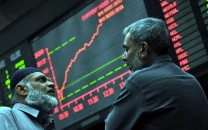Fiscal unsustainability: Economy showing mixed picture halfway into FY13
SBP releases report on the state of economy.

SBP says the economic outlook was strongly influenced by the perceived vulnerabilities in the external sector. PHOTO: FILE
The central bank, on Friday, released its own view on the state of the economy, by publishing report on the first half of fiscal 2013. In its reports, the State Bank of Pakistan said that positive developments experienced by the economy in the July to October quarter were unsustainable during the second quarter, October to December, as persistent structural problems continued to burden the economy.
According to the two reports that jointly cover development’s in Pakistan’s economy, the SBP painted a mixed picture of the economy for the first half of fiscal 2013.
The reports noted that the resilience of the informal sector appears to be pushing the formal economy forward.
Despite positive current account balance during the period, interruption in the downward trend of inflation and government’s reliance on financing from the central bank offset the impact of all positive developments.
Although the current account still posted a surplus in the first half of FY13, the second quarter posted a deficit; the downward trend in inflation in the first five months of FY13 was interrupted in December; and the federal government sharply increased its reliance on SBP financing in the second quarter.
Within agriculture, both cotton and rice crops remained below target, whereas sugarcane performed well. The wheat crop is likely to be below target despite the increase in support prices in November 2012.
The real sector showed a mixed picture, though on the other hand, the manufacturing sector posted an improvement, and is likely to continue with this trend. Heavyweights like petroleum products and steel manufacturing had shown strong growth. In addition, allied sub-sectors that support construction activities have shown consistent growth, reflecting strong construction since fiscal 2012.
Loans to the private sector witnessed an expansion of Rs146.5 billion, compared to Rs86.1 billion in the corresponding half last year, indicating that banks had shifted focus to private businesses.
Though, government borrowed less from the banking system in the period, the fiscal picture explains it’s compulsion to borrow. Fiscal deficit, where government’s total expenditures exceed revenues, stood at 2.6% of the gross domestic product, same as last year only due to the $1.8 billion inflow on account of the coalition support fund, which made all the difference.
Moreover, revenue collection witnessed an increase of a meagre 5.7%, whereas expenditures of the government grew 30.9% during the half.
Domestic debt rose by Rs691 billion against an increase of Rs854 billion in the first half of fiscal 2012. External debt, however, fell by $1.9 billion, of which $1.3 billion was owed to the International Monetary Fund.
“Repayments, without fresh inflows, did put pressure on the country’s balance of payments and the rupee-dollar exchange rate, which ideally should be countered by running a much larger current account surplus,” said the report.
In terms of trade flows, the picture was relatively benign as falling imports and softer commodity prices resulted in a fall in the import bill, which fell by 3.3%, data from Pakistan Bureau of Statistics shows.
Remittances – a key support to Pakistan’s economy – clocked in at $7.1 billion during the half, compared to $6.3 billion last year. The central bank estimates that full-year remittances will exceed $14 billion.
On the inflation front, although downward trend in year-on-year consumer price index was interrupted in December 2012, SBP feels the average inflation rate for the fiscal will remain within target.
SBP said that the outlook for the economy was strongly influenced by the perceived vulnerabilities in the external sector as the fall in currency reserves were dampening sentiments, not the size of the current account imbalance.
The fall in reserves has occasionally exerted pressure on the rupee-dollar parity, coinciding with monetary policy decisions and payments to the IMF.
Published in The Express Tribune, April 14th, 2013.
Like Business on Facebook to stay informed and join in the conversation.



















COMMENTS
Comments are moderated and generally will be posted if they are on-topic and not abusive.
For more information, please see our Comments FAQ